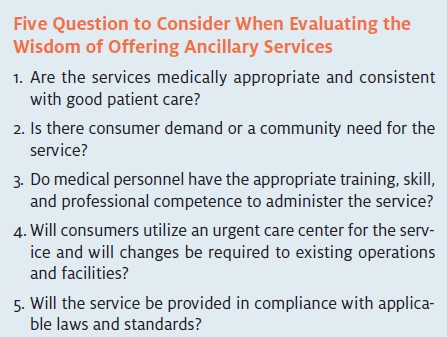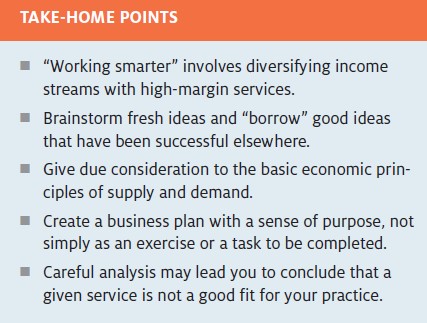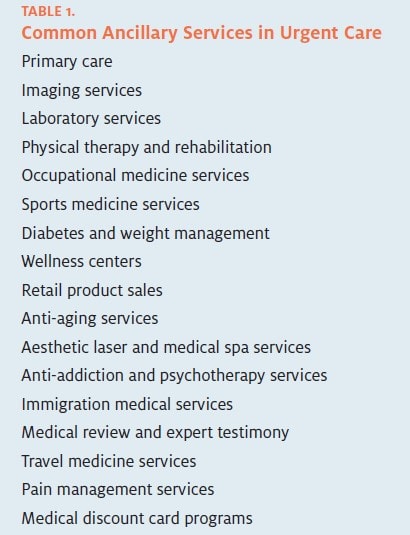Published on
Urgent message: With careful consideration and disciplined planning, ancillary services can add to your bottom line without significantly adding to your workload.
Alan A. Ayers, MBA, MAcc Practice Velocity
Could Charles Dickens’ discourse provide a better depiction of the urgent care business today? Unprecedented growth in recent years proves the value of a healthcare delivery model like urgent care, based on consumer needs for affordability and convenience.
But urgent care is not immune from challenges facing every other medical provider-e.g., declining third party reimbursement and rising operating expenses. Falling margins leave providers with just two options to work harder or to work smarter.
As you well know, urgent care providers are already working hard, seeing more patients per hour than ever and working longer hours to maintain their incomes. Working smarter involves diversifying income streams with high-margin services beyond the core business of walk-in care for illness and injury. It sounds easy enough, but successful implementation requires careful consideration and disciplined planning.
Lessons from the Retail Industry
Wal-Mart and Nordstrom are both profitable companies, but they attain their profitability in very different ways.
Wal-Mart and other mass retailers focus on volume; their profit is mere pennies on the dollar but they know that low prices will sell more merchandise, resulting in a higher net income.
A challenge for urgent care is that when third-party payors set prices for medical services and offer network participation on “take it or leave it” terms, a provider must lower his or her operating costs to remain profitable.
Because most costs in urgent care are fixed, the provider can be forced into a volume strategy of seeing more patients and working longer hours.
By contrast, Nordstrom and other specialty retailers focus on margin—limiting their appeal to a segment of consumers willing to pay more for personalized attention and unique merchandise. Nordstrom serves fewer customers than Wal-Mart, but makes more money on each sale. Likewise, urgent care providers who add high margin ancillary services can make more money by serving fewer patients.
A Structured and Disciplined Approach
All too often, entrepreneurial physicians succumb to a sales presentation to buy the latest and greatest equipment without a fully developed business case, only to be disappointed by a lack of volume.
Similarly, the decision to diversify revenue through ancillary services cannot be made by emotion; rather, it requires a structured and disciplined approach that includes understanding consumer needs and expectations; analysis of financial, legal, and operational implications; and a plan to execute and measure success.
Brainstorm
The best first step is a brainstorming session. Write down all of the potential services that could be offered in an urgent care setting (some examples are provided in Table 1). Be creative, drawing from needs ex- pressed by your patients and what you’ve seen done elsewhere.
At this point, nothing should be off limits do not exclude opportunities because of financing, training, or facility constraints. Those will be addressed later. When it is time to evaluate your list of ideas, ask yourself whether each opportunity is consistent with your interests, strategy, or values. If you don’t have a good “gut feeling” about an opportunity, strike it from the list.

Demand
The next step is to evaluate demand.
Demand for any service derives from consumer needs and desires. Before a retailer adds any product to its stores, it asks basic questions such as:
- Is this a product consumers want?
- How much will consumers pay?
- Will consumers buy this product from me instead of from my competitors?
The same questions should be asked of an urgent care provider when considering ancillary services.
For example, a provider interested in adding “medical spa” offerings such as treatment of facial lines and laser hair removal should first understand the target market (what is their age, where do they live, how much disposable income do they have…?), as well as the intrinsic and social needs that drive those people to improve their appearance. In the case of these serv- ices, the provider may find that the market is largely female, middle income, single or divorced, and driven by a perceived need to “extend youth,” boost their self-esteem, and become more appealing to the opposite sex.
Now, ask yourself this: Is this a market already served in your urgent care center, or would it be a new market you would have to attract? Selling additional products and services to existing customers is generally a more successful and less expensive strategy than marketing to an entire new group of consumers, particularly if the service is in response to an unmet need you know and understand.
Supply
After analyzing demand, it’s important to consider supply.
To continue our medical spa example, competitive analysis may uncover a host of providers at different price points, including dermatology and plastic surgery physician offices, day spas and destination resorts with nurses on site, and, in some states, podiatry and dental offices.
Low barriers to entry, such as vendor financing and weekend training, have made it easy for a variety of professionals to offer these services. As you identify competitors, ask how their facilities and other amenities compare to yours. Are they meeting consumer expectations?
If the consumers you’re trying to reach expect to receive medical spa services at an upscale facility with a full range of beauty products, it may be necessary to invest in fixtures and renovations to create an atmosphere more reminiscent of a “spa experience”—as some urgent care centers that success- fully offer aesthetic services have done. Otherwise, your market could be limited to price-conscientious consumers who don’t care about frills, and to compete you’d have to adopt a volume strategy by offering the lowest price.
Adding ancillary services is more than purchasing equipment, being trained, and running an ad, how- ever. A thorough understanding of consumer expectations and local competition is required.
Low barriers to entry and high competition almost always necessitate a volume strategy. To attain high margins, a practice needs to offer something unique, which may be as simple as added convenience to existing customers.
The higher the initial investment to get started or the presence of regulatory hurdles that limit the number of providers in an area, the more able a practice will be to capture and defend high margins.
Business Plan Development
Once a plausible opportunity has been identified, a business case should be developed that documents expected revenues, projected expenses, and any impact on existing operations. Projected revenue should include future trends in pricing and demand. Expenses should include capital expenditures for equipment, facility enhancements, staff training, and start-up marketing campaigns.
These data are used to create pro-forma financial statements and will demonstrate future effects on productivity and cash flow. As with starting a new urgent care center, losses should be expected until volume is sufficient to achieve profitability.
In addition to the pro- forma, you should create a formal business plan that evaluates competition, legal and regulatory hurdles (including Stark Laws, Medicare regulations and state/local re- strictions), marketing plans, and integration with current operational processes and systems.
While many people treat the business plan as a formality to attain financing, when done correctly it assures that all of the required analysis has taken place prior to investing. Short cuts, such as applying someone else’s business plan, can often lead to disastrous results because what is true of one market, location, or provider may not be true of another.
In fact, if the business planning process is followed correctly, many times the final decision will be to not proceed with a project. There are many great examples of urgent care practices that have successfully implemented the services in Table 1 and increased their bottom lines while better serving their patients.
A structured and disciplined approach to identifying, evaluating, and planning ancillary services can as- sure that your revenue diversification efforts result in the “best of times” and not the “worst.”



